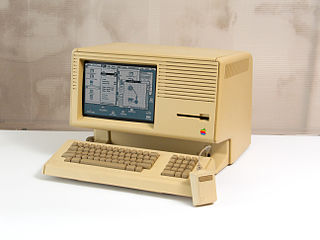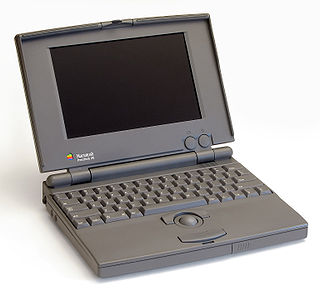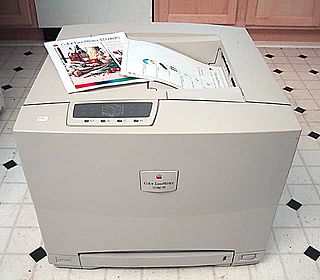AppleTalk is a discontinued proprietary suite of networking protocols developed by Apple Computer for their Macintosh computers. AppleTalk includes a number of features that allow local area networks to be connected with no prior setup or the need for a centralized router or server of any sort. Connected AppleTalk-equipped systems automatically assign addresses, update the distributed namespace, and configure any required inter-networking routing.

Apple Attachment Unit Interface (AAUI) is a mechanical re-design by Apple of the standard Attachment Unit Interface (AUI) used to connect Ethernet transceivers to computer equipment. AUI was popular in the era before the dominance of 10BASE-T networking that started in the early 1990s; AAUI was an attempt to make the connector much smaller and more user friendly, though the proprietary nature of the interface was also criticized.

Lisa is a desktop computer developed by Apple, released on January 19, 1983. It is one of the first personal computers to present a graphical user interface (GUI) in a machine aimed at individual business users. Its development began in 1978. It underwent many changes before shipping at US$9,995 with a five-megabyte hard drive. It was affected by its high price, insufficient software, unreliable Apple FileWare floppy disks, and the imminent release of the cheaper and faster Macintosh. Only 10,000 were sold in two years.

The Macintosh II is a personal computer designed, manufactured, and sold by Apple Computer from March 1987 to January 1990. Based on the Motorola 68020 32-bit CPU, it is the first Macintosh supporting color graphics. When introduced, a basic system with monitor and 20 MB hard drive cost US$5,498. With a 13-inch color monitor and 8-bit display card the price was around US$7,145. This placed it in competition with workstations from Silicon Graphics, Sun Microsystems, and Hewlett-Packard.

System 7, codenamed "Big Bang", and also known as Mac OS 7, is a graphical user interface-based operating system for Macintosh computers and is part of the classic Mac OS series of operating systems. It was introduced on May 13, 1991, by Apple Computer It succeeded System 6, and was the main Macintosh operating system until it was succeeded by Mac OS 8 in 1997. Current for more than six years, System 7 was the longest-lived major version series of the classic Macintosh operating system. Features added with the System 7 release included virtual memory, personal file sharing, QuickTime, QuickDraw 3D, and an improved user interface.

Andrew Jay Hertzfeld is an American software engineer and innovator who was a member of the original Apple Macintosh development team during the 1980s. After buying an Apple II in January 1978, he went to work for Apple Computer from August 1979 until March 1984, where he was a designer for the Macintosh system software. Since leaving Apple, he has co-founded three companies: Radius in 1986, General Magic in 1990, and Eazel in 1999. In 2002, he helped Mitch Kapor promote open source software with the Open Source Applications Foundation. Hertzfeld worked at Google from 2005 to 2013, where in 2011, he was the key designer of the Circles user interface in Google+.

System 6 is a graphical user interface-based operating system for Macintosh computers, made by Apple Computer It was released in 1988, and is part of the classic Mac OS series. It is a monolithic operating system, with cooperative multitasking based on an improved MultiFinder. The boxed version cost US$49, and it was included with all new Macintosh computers until 1991, when it was succeeded by System 7.

Macintosh XL is a modified version of the Apple Lisa personal computer made by Apple Computer. In the Macintosh XL configuration, the computer shipped with MacWorks XL, a Lisa program that allowed 64 K Macintosh ROM emulation. An identical machine was previously sold as Lisa 2/10 with the Lisa OS only.
Larry Pina is an author of five do-it-yourself repair manuals for Apple Macintosh computers and peripherals. Pina authored the Mac shareware utility Test Pattern Generator (TPG) which allowed users to test and measure various video screen characteristics via test patterns. Among other circumstances, Mac users could use the TPG utility after performing hardware upgrades to check if the screen alignment needed adjusting. According to several of the books, Pina was living in Westport, Massachusetts when they were published.
Macintosh Repair & Upgrade Secrets is a hardback book for repairing and upgrading Apple Macintosh personal computers from the Macintosh 128K to Macintosh SE models. The book was written by Larry Pina and is out of print. It was first published in 1990 by Hayden Books, with ISBN 0-672-48452-8.
Macintosh II Repair and Upgrade Secrets is a 264-page hardcover do-it-yourself book written by Larry Pina that describes how to repair and upgrade a Macintosh II personal computer. The book was first published in 1991 and is now out of print. It came with a diskette.
Hayden Book Company was an imprint of MacMillan Computer Publishing USA that published computing books, with a particular emphasis on the Macintosh platform and desktop design. Video games and educational software for home computers, such as Championship Golf, Sargon II, and Sargon III, were published as Hayden Software.
Goldstein & Blair Publishing was a publisher of Apple Macintosh-related books in the 1980s and early 1990s, including The Macintosh Bible. They also published one of Larry Pina's books.
StrataVision 3D is a comprehensive 3D computer graphics software package developed by Strata. Features include primitives-based modeling with texturising, keyframe animation, raytrace and later radiosity rendering under the name of Raydiosity.

The PowerBook 100 is a portable subnotebook personal computer designed and manufactured by Sony for Apple Computer and introduced on October 21, 1991, at the COMDEX computer expo in Las Vegas, Nevada. Priced at US$2,500 with external floppy drive, the PowerBook 100 was the low-end model of the first three simultaneously released PowerBooks. Its CPU and overall speed closely resembled those of its predecessor, the Macintosh Portable. It had a Motorola 68000 processor at 16 MHz, 2-8 megabytes (MB) of RAM, a 9-inch (23 cm) monochrome backlit liquid crystal display (LCD) with 640 × 400 pixel resolution, and the System 7.0.1 operating system. It did not have a built-in floppy disk drive and was noted for its unique compact design that placed a trackball pointing device in front of the keyboard for ease of use.

The Color LaserWriter was a line of PostScript four-color laser printers manufactured by Apple Computer, Inc. in the mid-1990s. These printers were compatible with PCs and Apple's own Macintosh line of computers; these printers were also able to connect to large networks by way of the use of an 10baseT Ethernet port. Two models were released.
Homer, from Blue Cow Software, was an IRC client for Apple Macintosh computer systems during the 1990s, written by Tob Smith, and distributed as shareware. System 7 or later of the classic Mac OS was required, as was MacTCP. It featured an icon view of users in a channel, which would animate when the user posted to the channel. It also provided notification of incoming CTCP Finger commands. Ircle included and extended this feature, "face files" to larger images. A late version of Homer reportedly allowed collaborative drawing across the network.

Global Village Communication Inc. was a leading manufacturer of easy-to-use fax modems and other telecommunications products for Apple's Macintosh platform. It was one of the few manufacturers to support the Mac's RS-422 serial ports without requiring an adapter. Major product lines included the TelePort series of high-speed desktop dial-up modems, and the PowerPort series of internal PowerBook modems, as well as a series of modems that connected to the Mac's ADB port. Many of its products were bundled with the Macintosh Performa series of computers, and it was the manufacturer for the internal modem in the PowerBook 500 series.

The MacEnhancer is an expansion box originally developed in 1985 by Microsoft for Apple Computer's original Macintosh. Plugged into either the Macintosh's serial printer or modem ports, the MacEnhancer provides IBM-standard printer and serial ports as well as a passthrough for the Mac-standard serial port, for a net gain of three peripheral ports. Along with a provided disk of drivers, this expansion box allows the Macintosh to run a host of printers and other business peripherals not originally supported by Apple.










